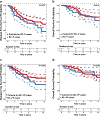Clinico-pathologic features, treatment and outcomes of breast cancer during pregnancy or the post-partum period
- PMID: 32162192
- PMCID: PMC7398490
- DOI: 10.1007/s10549-020-05585-7
Clinico-pathologic features, treatment and outcomes of breast cancer during pregnancy or the post-partum period
Abstract
Purpose: Breast cancer during pregnancy (BC-P) or the first year post-partum (BC-PP) is rare and whether it differs from breast cancer (BC) in young women not associated with pregnancy is uncertain.
Methods: We queried our institutional database for BC-P and BC-PP cases and matched controls with BC not associated with pregnancy diagnosed between January 1, 1985 and December 31, 2013. We performed two parallel retrospective cohort studies evaluating clinico-pathologic features, treatment and outcomes for BC-P and BC-PP cases compared to their controls.
Results: In our population of 65 BC-P cases, 135 controls for BC-P cases, 75 BC-PP cases and 145 controls for BC-PP cases, high grade and estrogen receptor-negativity were more frequent in both case groups than their controls. Among those with stage I-III BC, patterns of local therapy were similar for both case groups and their controls, with the majority undergoing surgery and radiation. Over three-fourths of those with stage I-III BC received chemotherapy. BC-P cases tolerated chemotherapy well, with the majority receiving doxorubicin/cyclophosphamide every 3 weeks. On multivariate analyses of those with stage I-III BC, BC-P cases had non-significantly higher hazards of recurrence and death compared to their controls, while BC-PP cases had non-significantly lower hazards of recurrence and death compared to their controls.
Conclusion: BC-P and BC-PP were associated with adverse clinic-pathologic features in our population. However, we did not observe inferior outcomes for BC-P or BC-PP compared to controls, likely due to receipt of aggressive multi-modality therapy.
Keywords: Breast cancer; Post-partum; Pregnancy; Prognosis; Young women.
Conflict of interest statement
Figures


Similar articles
-
Clinicopathological features and prognosis of pregnancy associated breast cancer - a matched case control study.Pathol Oncol Res. 2014 Jul;20(3):581-90. doi: 10.1007/s12253-013-9735-9. Epub 2013 Dec 20. Pathol Oncol Res. 2014. PMID: 24357159
-
Prognostic impact of pregnancy after breast cancer according to estrogen receptor status: a multicenter retrospective study.J Clin Oncol. 2013 Jan 1;31(1):73-9. doi: 10.1200/JCO.2012.44.2285. Epub 2012 Nov 19. J Clin Oncol. 2013. PMID: 23169515 Free PMC article.
-
Chemosensitivity, tumor infiltrating lymphocytes (TILs), and survival of postpartum PABC patients treated by neoadjuvant chemotherapy.Breast. 2018 Dec;42:61-67. doi: 10.1016/j.breast.2018.08.103. Epub 2018 Aug 28. Breast. 2018. PMID: 30179779
-
Regulatory T cells are an important prognostic factor in breast cancer: a systematic review and meta-analysis.Neoplasma. 2016;63(5):789-98. doi: 10.4149/neo_2016_517. Neoplasma. 2016. PMID: 27468884
-
Om.breast cancer in very young women aged 25 year-old or below in the center of Tunisia and review of the literature.Pathol Oncol Res. 2015 Jul;21(3):553-61. doi: 10.1007/s12253-015-9944-5. Epub 2015 May 12. Pathol Oncol Res. 2015. PMID: 25962349 Review.
Cited by
-
Experiences and challenges in the management of pregnancy-associated breast cancer at the Korle Bu Teaching Hospital: a review of four cases.Ecancermedicalscience. 2020 Nov 10;14:1140. doi: 10.3332/ecancer.2020.1140. eCollection 2020. Ecancermedicalscience. 2020. PMID: 33281932 Free PMC article.
-
The Predictive Value of Changes in the Absolute Counts of Peripheral Lymphocyte Subsets for Progression and Prognosis in Breast Cancer Patients.Contrast Media Mol Imaging. 2022 Aug 18;2022:3444360. doi: 10.1155/2022/3444360. eCollection 2022. Contrast Media Mol Imaging. 2022. PMID: 36051923 Free PMC article.
-
Cancer during Pregnancy: A Review of Preclinical and Clinical Transplacental Transfer of Anticancer Agents.Cancers (Basel). 2021 Mar 11;13(6):1238. doi: 10.3390/cancers13061238. Cancers (Basel). 2021. PMID: 33799824 Free PMC article. Review.
-
Clinical outcomes and prognostic biomarkers among pregnant, post-partum and nulliparous women with breast cancer: a prospective cohort study.Breast Cancer Res Treat. 2021 Oct;189(3):797-806. doi: 10.1007/s10549-021-06327-z. Epub 2021 Jul 27. Breast Cancer Res Treat. 2021. PMID: 34318391
-
Inflammatory Breast Carcinoma in Pregnancy: A Curious Case of a High-Grade Invasive Ductal Carcinoma Masquerading as a Breast Abscess in the Second Trimester.Cureus. 2024 Sep 9;16(9):e68984. doi: 10.7759/cureus.68984. eCollection 2024 Sep. Cureus. 2024. PMID: 39385889 Free PMC article.
References
MeSH terms
Substances
Grants and funding
LinkOut - more resources
Full Text Sources
Medical
Research Materials
Miscellaneous

